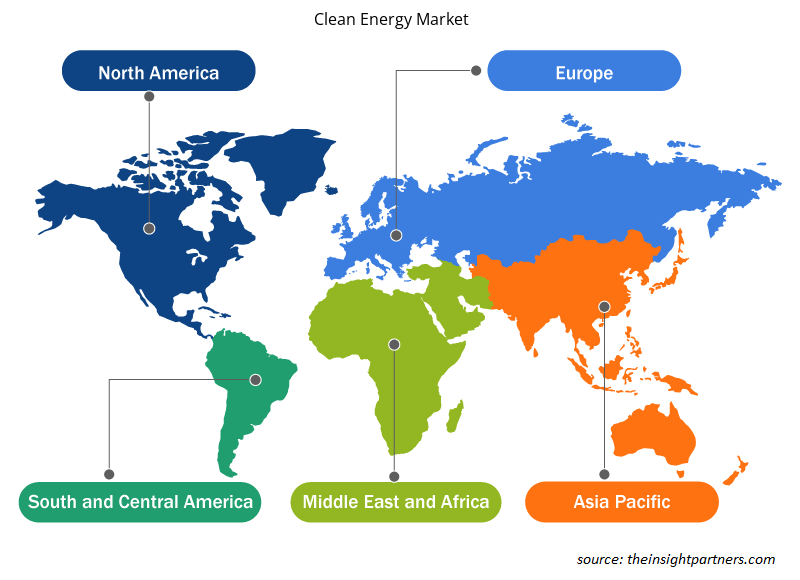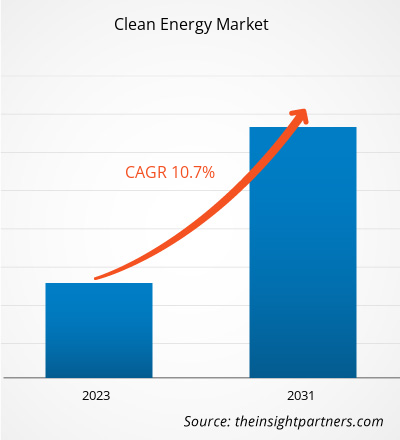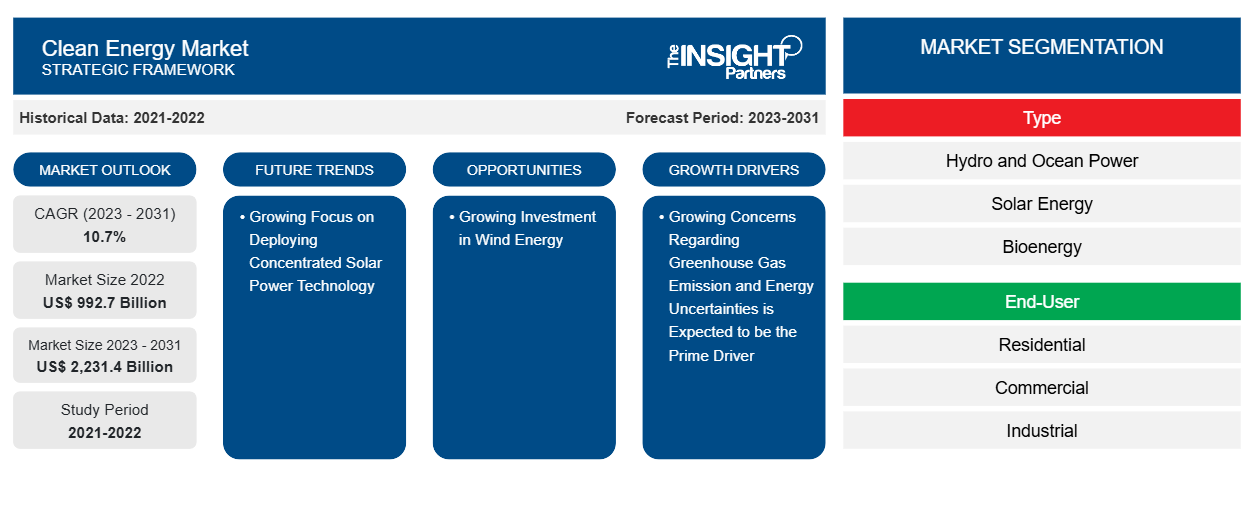预计到 2031 年,清洁能源市场规模将从 2022 年的 9927 亿美元增至 22314 亿美元。预计 2023-2031 年期间,该市场的复合年增长率将达到 10.7%。人们越来越关注减少温室气体排放、越来越重视可再生能源以促进可持续发展以及对环境保护的日益关注可能仍是市场的主要趋势。
清洁能源市场分析
全球能源环境的变化正在产生对更可持续能源的需求,以满足不断增长的能源需求。不断增长的能源需求凸显了清洁能源的重要性。预计在预测期内,由于各种地缘政治挑战导致的能源价格上涨和供应不确定性将推动清洁能源市场的增长。清洁能源的利用有助于减少煤炭和石油等标准能源对环境的不利影响。因此,全球多个国家的政府都实施了税收优惠和优惠政策,以鼓励采用清洁能源,这是市场的主要驱动因素。
清洁能源市场概况
随着人口增长和工业化,全球对能源的需求也在增加。这推动了对替代能源的需求,因为化石燃料等传统能源正在导致环境污染。太阳能和风能等清洁替代能源可抑制大量碳排放及其对环境的负面影响,并有助于平衡能源供需。因此,可再生能源行业的发展和政府采取可持续方式减少碳排放的支持性举措正在推动对风能、太阳能、地热能和水力等清洁能源的投资。
定制此报告以满足您的需求
您可以免费定制任何报告,包括本报告的部分内容、国家级分析、Excel 数据包,以及为初创企业和大学提供优惠和折扣
-
获取此报告的关键市场趋势。这个免费样品将包括数据分析,从市场趋势到估计和预测。
清洁能源市场驱动因素和机遇
对温室气体排放和能源不确定性的担忧日益加剧
《巴黎协定》于 2015 年启动,并于 2016 年生效。该协定推动了能源系统的进步,促进了清洁能源的使用,从而降低了碳排放。导致气候变化的温室气体排放的一个主要因素是利用化石燃料发电。由于人们越来越关注更可持续和更环保的能源替代品、日益增长的气候变化问题以及政府支持在全球范围内促进清洁能源使用,太阳能、风能、水力和地热等清洁能源的使用正在增加。一些经济体的政府认识到转向清洁能源以实现未来实现低碳排放至零碳排放目标的重要性。例如,美国政府的目标是到 2030 年将温室气体净排放量与 2005 年的水平相比降低约 50-52%,到 2050 年实现净零排放。同样,德国政府也设定了到 2030 年将碳排放量与 1990 年的水平相比降低约 65% 的目标。
由于俄乌战争导致欧洲能源不确定性增加,多个国家的政府都认识到了国内清洁能源的潜力。清洁能源市场包括电力来源,主要是风能、水力发电、地热能和太阳能。因此,对温室气体排放和能源不确定性的日益担忧成为清洁能源市场的主要驱动力。
加大对风能的投资以建立替代能源
风能主要以环保的方式帮助满足不断增长的能源需求,正在成为化石燃料的重要替代品。此外,各国政府正致力于投资陆上和海上风电项目,以减少对化石燃料的依赖,从而减轻碳排放及其对环境的毒性影响。海上风电项目被认为比陆上风电场更有效率,因为海上风电更稳定、风速更高,而且没有陆地的物理干扰。海上风电项目数量的增加也是全球清洁能源市场增长的主要推动因素。
清洁能源市场报告细分分析
有助于得出清洁能源市场分析的关键部分是类型和最终用户。
- 根据类型,清洁能源市场分为水力和海洋能、太阳能、生物能源、地热能和风能。水力和海洋能部分在 2023 年占据了最大的市场份额。
- 根据最终用户,市场分为住宅、商业和工业。住宅市场在 2023 年占据了市场主导地位。
清洁能源市场份额地域分析
清洁能源市场报告的地理范围主要分为五个区域:北美、欧洲、亚太、中东和非洲、南美和中美。
2023 年,亚太地区主导了清洁能源市场。人口增长和能源需求增加是推动亚太地区清洁能源市场发展的主要因素。此外,政府越来越注重采取支持措施和政策,以减少对化石燃料的依赖和减少碳排放,这很可能会推动该地区的清洁能源市场。日益严重的环境污染和严峻的气候变化影响是刺激对清洁替代能源的需求以减少化石燃料使用的主要问题。例如,印度可再生能源发展署为在该国开发符合条件的可再生能源项目提供低息贷款。印度的目标是到 2030 年实现可再生能源发电量累计安装量的 50%,到 2070 年实现净零碳排放。此外,2022 年,政府推出了“500GW 任务”行动计划,以实现总体可再生能源目标。
清洁能源市场区域洞察
Insight Partners 的分析师已详细解释了预测期内影响清洁能源市场的区域趋势和因素。本节还讨论了北美、欧洲、亚太地区、中东和非洲以及南美和中美洲的清洁能源市场细分和地理位置。

- 获取清洁能源市场的区域特定数据
清洁能源市场报告范围
| 报告属性 | 细节 |
|---|---|
| 2022 年市场规模 | 9927亿美元 |
| 2031 年市场规模 | 22314亿美元 |
| 全球复合年增长率(2023 - 2031) | 10.7% |
| 史料 | 2021-2022 |
| 预测期 | 2023-2031 |
| 涵盖的领域 |
按类型
|
| 覆盖地区和国家 |
北美
|
| 市场领导者和主要公司简介 |
|
清洁能源市场参与者密度:了解其对商业动态的影响
清洁能源市场正在快速增长,这得益于终端用户需求的不断增长,而这些需求又源于消费者偏好的不断变化、技术进步以及对产品优势的认识不断提高等因素。随着需求的增加,企业正在扩大其产品范围,进行创新以满足消费者的需求,并利用新兴趋势,从而进一步推动市场增长。
市场参与者密度是指在特定市场或行业内运营的企业或公司的分布情况。它表明在给定市场空间中,相对于其规模或总市场价值,有多少竞争对手(市场参与者)存在。
在清洁能源市场运营的主要公司有:
- Xcel 能源公司
- 法国电力能源公司
- 西门子能源股份公司
- 意大利国家电力公司
- 安德里茨公司
免责声明:上面列出的公司没有按照任何特定顺序排列。

- 了解清洁能源市场顶级关键参与者概况
清洁能源市场新闻和最新发展
清洁能源市场的评估是通过收集一手和二手研究后的定性和定量数据进行的,其中包括重要的公司出版物、协会数据和数据库。清洁能源市场的一些发展情况如下:
- 阿特斯太阳能公司宣布,中国江苏省扬州市政府与其控股子公司阿特斯太阳能有限公司签署了一份多年期投资协议。根据协议,阿特斯太阳能计划扩大扬州清洁能源制造工业园的产能,以制造垂直一体化高效硅片、电池和组件以及电池系统。(来源:新闻稿/公司网站/通讯,2023 年 1 月)
- Composites, Inc. (TPI) (Nasdaq: TPIC) 是一家专注于创新和可持续解决方案的全球性公司,该公司宣布已与 GE 可再生能源续签了至 2025 年的供应协议。GE 和 TPI 还制定了战略,共同开发 GE 的下一代叶片类型,包括在 GE 与 TPI 合作运营的 9 条生产线之外,在 2023 年增加更多生产线的可能性。(来源:新闻稿/公司网站/通讯,2023 年 1 月)
清洁能源市场报告范围和交付成果
“清洁能源市场规模和预测(2021-2031 年)”报告对以下领域进行了详细的市场分析:
- 范围内涵盖的所有主要细分市场的全球、区域和国家清洁能源市场规模和预测
- 清洁能源市场趋势以及市场动态,如驱动因素、限制因素和关键机遇
- 详细的 PEST/波特五力分析和 SWOT 分析
- 清洁能源市场分析涵盖主要市场趋势、全球和区域框架、主要参与者、法规和最新市场发展
- 行业格局和竞争分析,涵盖市场集中度、热点图分析、知名参与者以及清洁能源市场的最新发展
- 详细的公司简介
- 历史分析(2 年)、基准年、预测(7 年)及复合年增长率
- PEST和SWOT分析
- 市场规模、价值/数量 - 全球、区域、国家
- 行业和竞争格局
- Excel 数据集
近期报告
客户评价
购买理由
- 明智的决策
- 了解市场动态
- 竞争分析
- 客户洞察
- 市场预测
- 风险规避
- 战略规划
- 投资论证
- 识别新兴市场
- 优化营销策略
- 提升运营效率
- 顺应监管趋势























 获取免费样品 - 清洁能源市场
获取免费样品 - 清洁能源市场